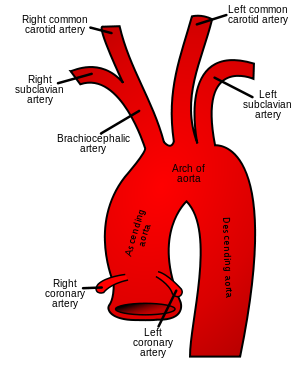Dysphagia lusoria
Dysphagia lusoria (or Bayford-Autenrieth dysphagia) is an abnormal condition characterized by difficulty in swallowing caused by an aberrant right subclavian artery. It was discovered by David Bayford in 1761 and first reported in a paper by the same in 1787.[1]
| Dysphagia lusoria | |
|---|---|
 | |
| The right subclavian artery is involved in this condition |
Pathophysiology
During development of aortic arch, if the proximal portion of the right fourth arch disappears instead of distal portion, the right subclavian artery will arise as the last branch of aortic arch. It then courses behind the esophagus (or rarely in front of esophagus, or even in front of trachea) to supply blood to right arm. This causes pressure on esophagus and results in dysphagia. It can sometimes result in upper gastrointestinal tract bleeding.[2] Investigation of choice - CT angiography
Treatment
Surgical repair is performed. Reconstruction or ligation of aberrant right subclavian artery by sternotomy/by neck approach.
Eponym
David Bayford called it dysphagia lusoria because in Latin, lusus naturæ means sports of nature or natural anomaly.[3] Bayford-Autenrieth dysphagia is eponym for Bayford and Autenrieth.
References
- Asherson N (January 1979). "David Bayford. His syndrome and sign of dysphagia lusoria". Ann R Coll Surg Engl. 61 (1): 63–7. PMC 2494476. PMID 369446.
- Vehling-Kaiser, U. (1993). "Lusorian artery lesion as rare cause of severe upper gastrointestinal tract bleeding". Digestive Diseases and Sciences. 38 (1): 178–180. doi:10.1007/BF01296793.
- Mahmodlou, Rahim; Sepehrvand, Nariman; Hatami, Sanaz (2014). "Aberrant Right Subclavian Artery: A Life-threatening Anomaly that should be considered during Esophagectomy". Journal of Surgical Technique and Case Report. 6 (2): 61–63. doi:10.4103/2006-8808.147262. PMC 4290042. PMID 25598945.